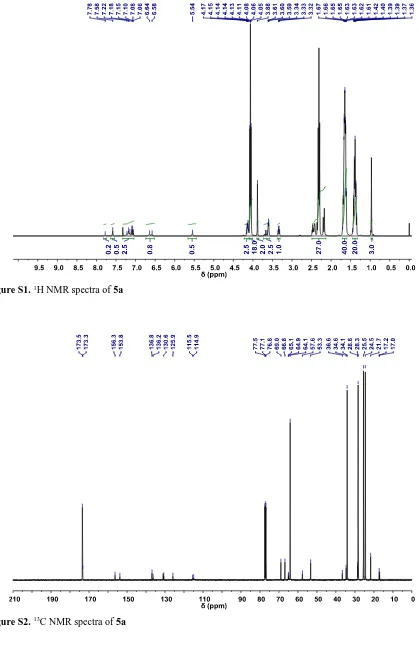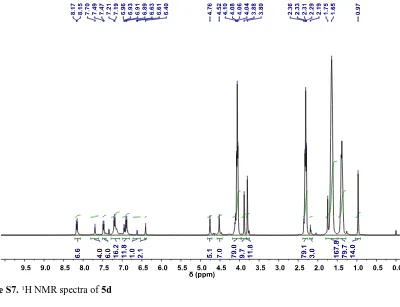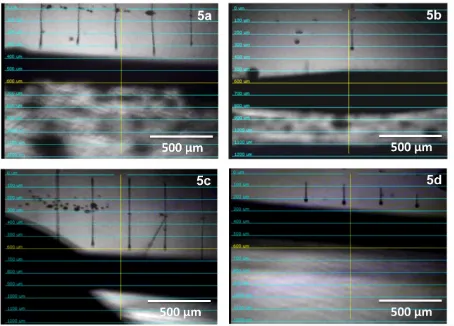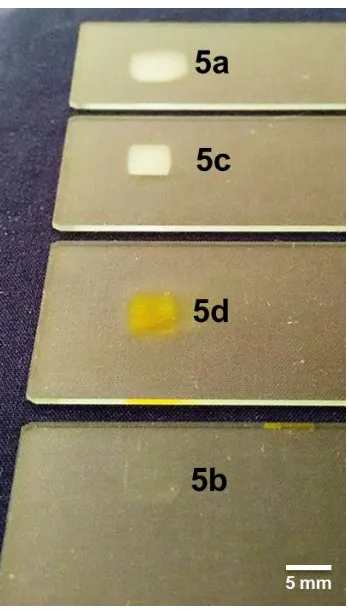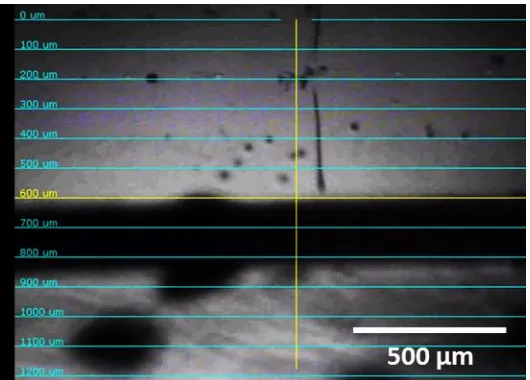S1
Supporting Information
3D Printing of Biocompatible Supramolecular Polymers and their
Composites
Lewis R. Hart,
aSiwei Li,
bRicky Wildman,
cJulian Jones
band Wayne Hayes*
aa Department of Chemistry, University of Reading, Whiteknights, Reading, RG6 6AD, U.K. e-mail:
w.c.hayes@reading.ac.uk, Tel: +44 (0)118 378 6491, Fax: +44 (0)118 378 6331
bDepartment of Materials, Imperial College London, South Kensington Campus, London, SW7 2BP, U.K. cDepartment of Chemical and Environmental Engineering, The University of Nottingham, University Park,
Nottingham, NG7 2RD, U.K.
Contents
Experimental S2
Figure S1. 1H NMR spectra of 5a S4
Figure S2. 13C NMR spectra of 5a S4
Figure S3. 1H NMR spectra of 5b S5
Figure S4. 13C NMR spectra of 5b S5
Figure S5. 1H NMR spectra of 5c S6
Figure S6. 13C NMR spectra of 5c S6
Figure S7. 1H NMR spectra of 5d S7
Figure S8. 13C NMR spectra of 5d S7
Figure S9. Viscosity analysis of polymers 5a-d in solution S8
Figure S10. Drop shape analysis and surface tension of solutions of polymers 5a-d S8
Figure S11. Image of test printing rig used to develop waveforms S9
Figure S12. Waveforms developed using test-rig printer S9
Figure S13. Drop watcher images of the four supramolecular polymers 5a-d S10
Figure S14. Image of the printed samples of supramolecular polymers 5a-d S11
Figure S15. Microscopy images of the hybrid solutions of 5c silica particles S11
Figure S16. Drop watcher image of the hybrid containing 5c and 5% silica particles S12
Figure S17. ESEM micrographs of printed polymer 5c and the hybrid materials S12
S2
Synthesis of 4-(2-aminoethyl) morpholine terminated SPU with 2,4-TDI and poly(caprolactone) diol (5a)
To poly(caprolactone) diol 1 [Mn = 2000 Da] (4×10-3 M) in a molten state at 80 °C was added the
2,4-toluenediisocyanate 2 (8.4×10-3 M) in the bulk before stirring the mixture for three hours at 80 °C
under a nitrogen atmosphere. Dry THF (80 mL) was added and the pre-polymer 3 solution was left to cool slightly before4-(2-aminoethyl) morpholine 4a (9.2×10-3 M) was added and the solution stirred
for three hours at 80 °C. The volume of solvent was then reduced in vacuo and the crude product
purified by repeated slow precipitations into methanol before drying under vacuum at 60 °C for 12
hours to afford polymer 5a as a tacky off-white solid (8.63 g, 81%); IR (ATR) v/cm-1: 3349, 2943,
2864, 1721, 1536, 1366, 1238, 1186, 1044; 1H NMR (400 MHz/CDCl
3) δ ppm: 7.78 (0.3H, s), 7.58
(0.5H, s), 7.22-7.06 (2.5H, m), 6.64-6.58 (0.8H, br), 5.54 (0.5H, s), 4.17-4.08 (2.5H, m), 4.08-3.88
(18H, t, J = 7.0 Hz), 3.88 (2H, s), 3.60 (2.5H, t, J = 4.5 Hz), 3.33 (1H, q, J = 5.5 Hz), 2.5-2.13
(27H, m), 1.67-1.58 (40H, m), 1.49-1.29 (20H, m), 0.97 (3H, s); 13C NMR (100 MHz/CDCl
3) δ ppm:
173.5, 173.3, 156.3, 153.8, 136.8, 136.2, 130.6, 125.9, 115.5, 114.9, 69.0, 66.8, 65.1, 64.9, 64.1, 57.6,
53.3, 36.6, 34.6, 34.1, 28.6, 28.3, 25.5, 24.5, 21.7, 17.2, 17.0; GPC (THF) Mn = 6637 Da, Mw = 9961
Da, Đm = 1.501; DSC: Tg = -49.10 °C, Tm = 37.04 °C
Synthesis of Ureidopyrimidinone terminated SPU with 2,4-TDI and poly(caprolactone) diol (5b)
To poly(caprolactone) diol 1 [Mn = 2000 Da] (4×10-3 M) in a molten state at 80 °C was added the
2,4-toluenediisocyanate 2 (8.4×10-3 M) in the bulk before stirring the mixture for three hours at 80 °C
under a nitrogen atmosphere. Dry DMAc (80 mL) was added and the pre-polymer 3 solution was left to cool slightly before 2-Amino-4-hydroxy-6-methylpyrimidine 4b (9.2×10-3 M) was added and the
solution stirred for three hours at 80 °C. The volume of solvent was then reduced in vacuo and the
crude product purified by repeated slow precipitations into methanol before drying under vacuium at
60 °C for 12 hours to afford polymer 5b as a white solid (8.06 g, 76%); IR (ATR) v/cm-1: 3346, 3018,
2942, 2865, 1724, 1624, 1536, 1455, 1227, 1160, 1028, 748; 1H NMR (400 MHz/CDCl
3) δ ppm:
9.55-9.29 (2.5H, m), 9.10 (0.25H, s), 8.71-8.64 (1.5H), 8.36-8.17 (48H, s), 8.17-8.10 (1H, m)
8.10-7.91 (1.0 H, m), 7.53 (1.5H, s), 7.33-6.97 (7H, m), 6.88-6.70 (0.75H, m), 6.62-6.32 (1.5H, br),
5.90-5.76 (1H, m), 5.39 (0.5H, s), 4.16-3.90 (120H, br), 3.88 (2H, s), 3.82 (10H, s), 3.73 (1H, s), 3.64 (2H,
s), 3.46-3.31 (7H, br), 3.25-3.16 (100H, br), 2.95 (12H, s), 2.80 (11H, s), 2.55 (2.5H, m), 2.38-2.09
(99H, br), 1.99-1.94 (16H, m), 1.68-1.43 (168H, m), 1.44-1.23 (84H, m), 0.91 (15H, s); 13C NMR
(100 MHz/CDCl3) δ ppm: 172.5, 172.4, 169.5, 155.3, 154.2, 153.4, 146.3, 137.2, 136.4, 129.9, 125.2,
121.6, 114.8, 112.0, 105.2, 100.2, 68.3, 63.7, 63.4, 52.7, 51.4, 48.5, 39.4, 38.9, 37.3, 34.2, 33.3, 28.2,
S3
Synthesis of benzylamine terminated SPU with 2,4-TDI and poly(caprolactone) diol (5c)
To poly(caprolactone) diol 1 [Mn = 2000 Da] (4×10-3 M) in a molten state at 80 °C was added the
2,4-toluenediisocyanate 2 (8.4×10-3 M) in the bulk before stirring the mixture for three hours at 80 °C
under a nitrogen atmosphere. Dry DMAc (80 mL) was added and the pre-polymer 3 solution was left to cool slightly before benzylamine 4c (9.2×10-3 M) was added and the solution stirred for three hours
at 80 °C. The volume of solvent was then reduced in vacuo and the crude product purified by repeated
slow precipitations into methanol before drying under vacuum at 60 °C for 12 hours to afford polymer
5c as a tacky white solid (8.77 g, 84%); IR (ATR) v/cm-1: 3353, 2942, 2865, 1727, 1536, 1220, 1159,
1096, 1065, 750; 1H NMR (400 MHz/CDCl
3) δ ppm: 7.77 (0.5H, s), 7.69-7.64 (2.5H, m), 7.35-7.16
(33H, br), 7.14-6.92 (5.5H, m), 6.87 (2H, s), 6.68 (0.5H, s), 6.01-5.90 (2H, br) 4.40-4.20 (5H, m),
4.18-4.00 (82H, m), 3.88 (10H, s) 3.74 (2.5H, t, J = 8Hz), 2.44-2,19 (89H, m), 2.18 (5H, s), 2.03
(7.5H, s), 1.77-1.49 (166H, m), 1.46-1.24 (84H, m), 0.97 (14H, s); 13C NMR (100 MHz/CDCl 3)
δ ppm:173.5, 156.2, 154.0, 139.4, 137.0, 136.6, 130.6, 128.4, 127.3,126.9, 115.1, 114.3, 68.9, 67.8,
64.7, 64.1, 50.4, 43.9, 34.6, 34.0, 28.5, 28.3, 24.5, 21.7, 17.0; GPC (THF) Mn = 6676 Da,
Mw = 9508 Da, Đm = 1.424; DSC: Tg = -48.39 °C, Tm = 34.03 °C.
Synthesis of N-(4-methoxybenzyl)-1-(4-nitrophenyl)methanamine terminated SPU with 2,4-TDI and poly(caprolactone) diol (5d)
To poly(caprolactone) diol 1 [Mn = 2000 Da] (4×10-3 M) in a molten state at 80 °C was added the
2,4-toluenediisocyanate 2 (8.4×10-3 M) in the bulk before stirring the mixture for three hours at 80 °C
under a nitrogen atmosphere. Dry DMAc (80 mL) was added and the pre-polymer 3 solution was left to cool slightly before N-(4-methoxybenzyl)-1-(4-nitrophenyl)methanamine 4d (9.2×10-3 M) was
added and the solution stirred for three hours at 80 °C. The volume of solvent was then reduced in
vacuo and the crude product purified by repeated slow precipitations into methanol before drying
under vacuum at 60 °C for 12 hours to afford polymer 5d as an orange viscous oil (8.97 g, 75 %); IR (ATR) v/cm-1: 3024, 2945, 2881, 1722, 1547, 1329, 1233, 1184, 1024, 758; 1H NMR (400
MHz/CDCl3) δ ppm: 8.21-8.07 (6.5H, d, J = 8.5 Hz), 7.79-7.65 (4H, br), 7.56-7.35 (6H, m), 7.29-7.09
(16H, m), 7.00-6.80 (12H, m), 6.66-6.57 (1H, m), 6.40 (2H, s), 4.76 (5H, s), 4.52 (7H, s), 4.18-3.97
(79H, m), 3.88 (10H, s), 3.80 (12H, s), 2.46-2.20 (79H, m), 2.18-2.13 (3H, m), 1.90-1.50 (168H, m),
1.46-1.28 (80H, m), 0.97 (14H, s); 13C NMR (100 MHz/CDCl
3) δ ppm: 173.5, 173.3, 159.5, 153.7,
147.3, 145.7, 137.0, 136.7, 130.4, 128.0, 123.8, 123.2, 114.6, 68.9, 64.7, 64.1, 55.3, 50.8, 50.7, 34.6,
34.0, 28.3, 25.5, 24.5, 21.7, 17.0, 16.6; GPC (THF) Mn = 8224 Da, Mw = 12971 Da, Đm = 1.577;
S4
[image:4.595.98.501.74.378.2]Figure S1.1H NMR spectra of 5a
S5
[image:5.595.90.501.303.681.2]Figure S3.1H NMR spectra of 5b
S6
[image:6.595.98.498.72.399.2]Figure S5.1H NMR spectra of 5c
S7
[image:7.595.97.497.73.380.2]Figure S7.1H NMR spectra of 5d
S8
[image:8.595.126.469.94.330.2]
Figure S9. Viscosity analysis at 20 °C of the supramolecular polymers 5a-d at 150 mM inDMAc/Chloroform
(2:1, v/v).
Figure S10. a:Typical drop shape produced by supramolecular polymers 5a-d and b: their respective surface
[image:8.595.116.486.437.549.2]S9
Figure S11. Image of test printing rig used to develop waveforms.
[image:9.595.180.420.71.391.2]
Figure S12. Waveforms developed using test-rig printer. Waveform ‘a’ where 100% corresponds to 27 V and
[image:9.595.192.422.445.596.2]S10
Figure S13. Drop watcher images of the four supramolecular polymers 5a-d using waveform ‘a’ (5a, 5b, and
[image:10.595.74.528.70.396.2]S11
Figure S14. Image of the printed samples of supramolecular polymers 5a, 5b, 5c, and 5d deposited onto clean
glass slides. Each feature is 300 layers in thickness – ca. >1 mm.
Figure S15. Microscopy images of the hybrid solutions of 5c with 5% or 7.5% silica particles at 10 (a & c) and
[image:11.595.106.492.429.724.2]S12
Figure S16.Drop watcher image of the hybrid containing 5c and 5% silica particles showing slight deflection of
the drop from the vertical.
Figure S17. ESEM micrographs of printed samples of the polymer 5c (a), and the hybrid material with silica
[image:12.595.75.526.325.554.2]